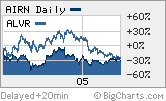 |
| To the Max: Alvarion and Airspan have been volatile stocks but they could be a good long-term bet on WiMax. |
|
|
|
|
|
|
|
| More about wireless trends
|
|
|
|
|
NEW YORK (CNN/Money) -
WiMax is finally ready for prime time.
WiMax, which stands for worldwide interoperability for microwave access, could drastically change the way consumers and businesses access the Internet.
In a nutshell, WiMax is a souped-up version of Wi-Fi (or wireless fidelity), technology that allows computers and other devices to connect to the Web through so-called "hot spots" -- public areas that are connected to local wireless networks.
The biggest difference between WiMax and Wi-Fi is that the WiMax standard offers much faster data speeds and wider coverage. A typical Wi-Fi hot spot covers a small area such as an office or storefront, while a WiMax station should be able to provide access to the Internet over a range of 30 miles.
Intel, the world's largest maker of chips used in computers and servers, announced last week that it has begun shipping a WiMax chip called PRO/Wireless 5116 (it was formerly codenamed Rosedale), bringing the technology much closer to the mass-adoption phase.
Tech observers think that Intel's embracing of WiMax will lead to broader acceptance of the standard, similar to how Intel's Centrino Wi-Fi chipset -- which came out in 2003 -- led to a greater proliferation of computers that could connect to the Internet through wireless connections.
Who will benefit from WiMax?
So with all that said, investors have to be wondering which public companies stand to gain if WiMax takes off.
Of course, Intel (Research) would be a prime beneficiary. The Centrino has been a big success for Intel, helping to lift margins for the company, as wireless chips tend to be more profitable than standard processors for desktops. Japanese tech conglomerate Fujitsu (Research) also recently unveiled a WiMax chip.
But there are other, albeit more speculative, ways for investors to jump aboard the WiMax express. There are a handful of small telecom equipment firms, most notably Airspan Networks (Research) and Alvarion (Research), that make WiMax networking gear.
Kevin Dede, an analyst with Merriman Curhan Ford, said that both companies have ample opportunities to grow in the next few years now that Intel's chips are available.
To that end, analysts are predicting a long-term earnings growth rate of 22.5 percent for Airspan and 30 percent growth rate for Alvarion.
However, it will probably be some time before the WiMax market really hits it big, said Erik Zamkoff, an analyst with IRG Research.
That's because at first, WiMax will be rolled out on a "fixed" basis, mainly for computers in rural areas where it isn't economically feasible for telecoms and cable companies to build the infrastructure necessary to bring DSL or cable modem lines into homes and offices. Zamkoff thinks the fixed WiMax market could reach about $2 billion in sales within the next few years.
Analysts think WiMax could be a really big business when mobile WiMax services become available. This would allow people to tap into a WiMax connection anywhere with laptops or other wireless devices. And that's where the WiMax promise really lies, with Zamkoff estimating a market size of $20 billion for mobile WiMax equipment.
Don't ignore the risks
Still, it's far from certain that WiMax will be the proverbial next "killer app" in tech. To be sure, several makers of cell phones, including Samsung and LG, and carriers, such as Sprint (Research), have discussed plans for WiMax products and services.
But wireless carriers have already started to deploy another broadband wireless technology, known as 3G, and wireless followers are debating whether WiMax and 3G will be complimentary technologies or competitors.
In addition, Dede points out that Airspan and Alvarion could face tough competition from larger telecom equipment companies, especially once mobile WiMax services start rolling out, which most analysts expect to happen in late 2006.
Currently, Airspan has a reselling agreement in place with British networking gear maker Marconi (Research), while Alvarion has similar deals in place with Lucent (Research), Alcatel (Research) and Siemens (Research).
But Dede said that these larger firms might ultimately decide that they don't need partners. Motorola (Research), for example, already makes its own WiMax gear, called Canopy.
"It will be interesting to see if any of these other companies will look at spending on their own equipment," said Dede.
Because of these risks, stocks of both Airspan and Alvarion have been extremely volatile during the past few months.
Still, if you believe WiMax is the next big trend in tech, these companies could be worth the risk. Joe Annoni, an analyst with Roth Capital Partners, says that larger competitors could decide it makes more sense to buy these companies outright as opposed to building their own equipment.
That takeover potential doesn't seem to be priced into the shares, which, while not cheap, aren't trading at exorbitant valuations either.
Alvarion appears to be the better bet, trading at 31 times this year's earnings estimates and 16 times projections for next year. Airspan, which is not expected to make money this year, has a P/E of 30 times 2006 estimates.
For more about personal technology, click here.
For more about Intel, click here.
Analysts quoted in this story do not own shares of the companies mentioned and their firms have no investment banking ties to the companies.
Sign up to receive the Tech Investor column by e-mail.
Plus, see more tech commentary and get the latest tech news.

|